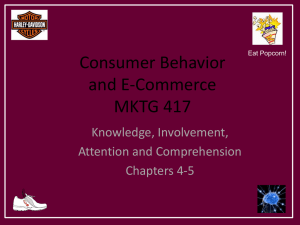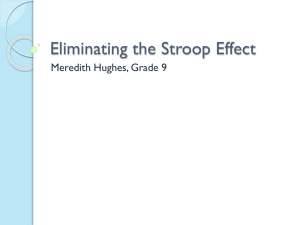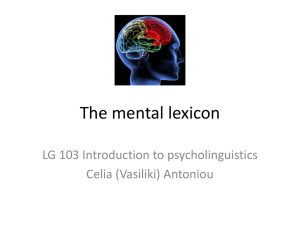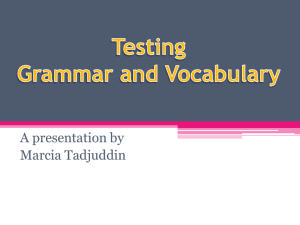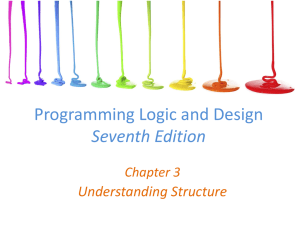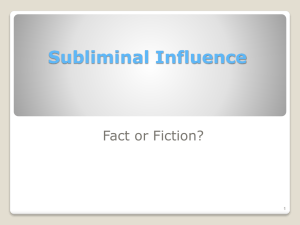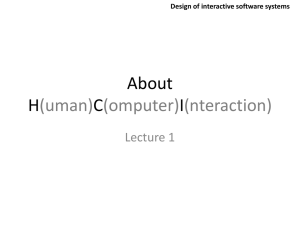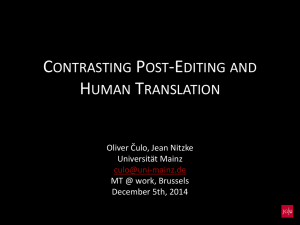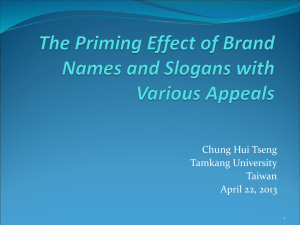Sample 2-back task
advertisement
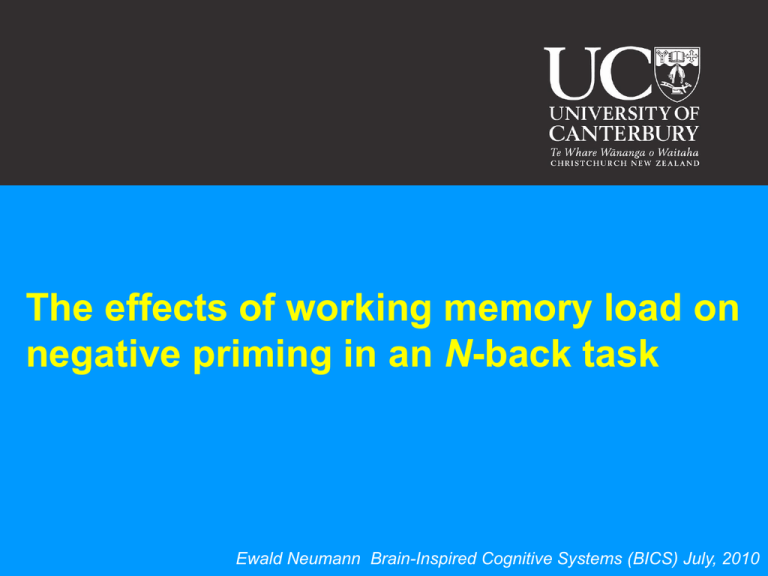
The effects of working memory load on negative priming in an N-back task Ewald Neumann Brain-Inspired Cognitive Systems (BICS) July, 2010 de Fockert, Rees, Frith, & Lavie (2001). The Role of Working Memory in Visual Selective Attention. Science, 291 500 ms 1500 ms . Example of a high memory load trial sequence involving a Congruent and an Incongruent attention display. Correct answer to memory item is 4. Exp. 1 N = 10 Interference 850 ms 825 2 to 4 attention displays are presented for 500 ms, each followed by a 1250 ms blank response interval. 775 Incong 675 625 3000 ms Cong 725 Low Load High Load de Fockert, Rees, Frith, & Lavie (2001). The Role of Working Memory in Visual Selective Attention. Science, 291 . 500 ms 1500 ms Exp. 2 N = 6 Interference 850 ms 825 775 2 to 4 attention displays are presented for 500 ms, each followed by a 1250 ms blank response interval. Cong 725 Incong 675 625 3000 ms Low Load High Load de Fockert, Rees, Frith, & Lavie (2001). The Role of Working Memory in Visual Selective Attention. Science, vol. 291. Summary of results and conclusions • RTs in the selective attention task revealed that interference from incongruent (versus congruent) distractor faces was significantly greater with high working memory load than with low working memory load. • High memory load leads to greater intrusion of irrelevant distractors, because of difficulty in prioritizing targets from distractors. • Low memory load enables more successful filtering, or blocking out of irrelevant distractors, thus minimizing intrusion from distractors. Why is it important to eliminate Congruent stimuli in Stroop-like conflict tasks? Because it is known that having congruent stimuli in Stroop-like conflict tasks induces subjects to maintain less attentional selectivity solely to the target. That is why participants consistently show greater amounts of interference in Incongruent trials as a function of increasing the proportion of Congruent trials in such conflict tasks (e.g., Lindsay & Jacoby, 1994). Why is it important to eliminate Congruent stimuli in Stroop-like conflict tasks (cont’d)? Since one of the stated objectives in using the present paradigm was to investigate selective attention, rather than more diffuse or divided attention, it is important to try to induce maximal attentional selectivity. Including Congruent stimuli in the task could be counterproductive in that regard. In addition, assessing “interference” by contrasting Congruent vs. Incongruent conditions is another potential problem in their study. By doing so, it is not possible to disentangle the interference cost from incongruent stimuli from the potential benefit in processing due to congruent stimuli. To illustrate, consider their results from Experiment 1 again: de Fockert, Rees, Frith, & Lavie (2001). The Role of Working Memory in Visual Selective Attention. Science, 291 500 ms 1500 ms 850 ms . To assess “interference” more purely, the Incongruent condition should be contrasted with a neutral Control condition, not a Congruent condition. Exp. 1 N = 10 Interference 825 2 to 4 attention displays are presented for 500 ms, each followed by a 1250 ms blank response interval. 775 Incong 675 625 3000 ms Cong 725 Low Load High Load Why is it important to have an “ignored repetition” (negative priming) condition in Stroop-like conflict tasks? In some instances negative priming effects can provide a more sensitive behavioral index, than concurrent interference effects, regarding the depth to which distractors have been processed. Why is it important to have an “ignored repetition” (negative priming) condition in Stroop-like conflict tasks? Name the color of the “odd man out” letter task Problems with inferences from null results XXXXX XXXX vs G R E E N (no Stroop interference) BLUE (significant negative priming) The Stroop color-naming effect has often been taken as evidence for the automaticity of word processing. However, Besner et al. (1997) reported that coloring a single letter instead of the whole word eliminated the Stroop effect. From this finding, they concluded that word processing could not be purely automatic, since it can be prevented. Mari-Beffa et al. (2000) asked whether the elimination of the Stroop effect is sufficient evidence for concluding that the word is not processed. Combining Besner et al.'s manipulation with a negative-priming procedure, she found intact negative priming from the prime color word in the absence of a Stroop effect. This result clearly indicates that the meaning of the prime word was processed. These findings highlight the importance of using converging methods to evaluate lack of processing. Main goal of the present study: Test implications of the working memory load theory in a new experiment designed to eliminate some of the potential flaws I just outlined. Method - regarding memory load: The N-back task is used extensively as a way to manipulate working memory (WM) load. Typically, in the N-back task participants are presented with a stream of stimuli, and the task is to decide for each stimulus if it matches the one N items before. The WM processing load can be varied systematically by manipulating the value of N. WM load is deemed to be low in a 1-back task and high in a 2-back task. Method - regarding selective attention: Because this study is designed to investigate how WM and visual selective attention interact, this N-back task also involved selective attention. Sample 1-back task: Respond “same” if the immediately preceding picture is of the same object, otherwise respond “different.” Red Picture Targets (ignore green letters) Schematic illustration of stimulus configuration Sample 2-back task: Respond “same” only if a picture is of the same object that was 2 pictures back, otherwise respond “different.” Red Picture Targets (ignore green letters) Sample experimental trials Ignored Repetition Control Response Same (bird then bird) Insertion here of an unrelated picture creates a 2-back trial. Different (bird then finger) Different (ashtray then bird) Probe Displays Prime Displays 1-back sample stream of stimuli 2-back sample stream of stimuli Sample experimental trials Ignored Repetition Control Response Same (bird then bird) Insertion here of an unrelated picture creates a 2-back trial. Different (bird then finger) Different (ashtray then bird) Probe Displays Prime Displays Results Mean RT and % Error for Control vs. Ignored Repetition (IR) conditions as a function of Low vs. High Working Memory Load Negative Priming (RT) 875 825 Negative Priming % Errors 3.5 3 Control Control IR 2.5 IR 2 775 1.5 1 725 0.5 0 675 1-back Low Load 2-back High Load 1-back Low Load 2-back High Load Results summary and implications: RTs and Errors much greater in 2-back than 1-back task suggests WM load manipulation was successful. RTs significantly longer in Ignored Repetition (IR) condition than Control condition, and Errors occurred significantly more often in the IR than Control condition, which indicates that ignoring a picture’s name can impede response to the picture on the following trial. This negative priming effect was produced in both the 1- and 2-back versions of the task. For RTs there was no interaction between the N- back and priming conditions; however, the error rate analysis for this interaction was significant. In this case, it appears that greater WM demands in the 2-back task did yield an exaggerated difference in the error rates between the IR and Control conditions, compared to the 1-back task. This provides some support for the idea that participants may be better able to block or filter out distractors under low WM load. Summary and Conclusions regarding how WM and selective attention interact: At least according to the error rates, the present findings could be interpreted to suggest that the working memory system is modulating attention and affecting processing within the brain’s recognition system. High WM load might reduce the efficiency of early selection and increase the effects of irrelevant stimuli. In contrast, Low WM load might enable relatively increased efficiency of early selection so that participants are better able to block or filter out the irrelevant distractors under low memory load conditions, as proposed by de Fockert et al. (2001). End
